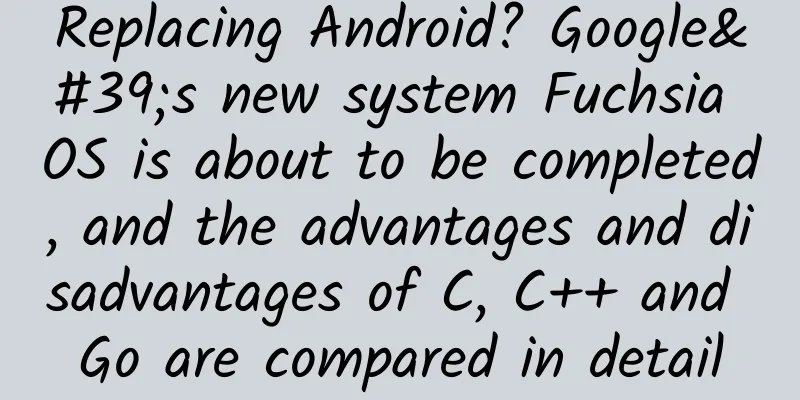Replacing Android? Google's new system Fuchsia OS is about to be completed, and the advantages and disadvantages of C, C++ and Go are compared in detail

|
Fuchsia OS, an experimental operating system being developed by Google, has sparked a lot of speculation among the public, such as whether it will replace the Android system. In fact, this is the third operating system developed by Google after Android and Chrome OS, and it is a "non-Linux" system that uses Google's new microkernel Zircon and uses Dart and Flutter to create a new UI. According to the latest report from foreign media, the work on Fuchsia OS has been basically completed, and after going through Google's internal "dog food" testing process, it will be officially launched to the market. What is Fuchsia OS?
Although Google has not officially announced Fuchsia's strategic position in Google, a Bloomberg report speculates that Fuchsia is Google's attempt to use a single operating system to unify the entire ecosystem. Fuchsia's goal is to be able to run on any suitable device such as smartphones, smart speakers, laptops, etc. based on Google's ecosystem. According to internal sources, Google plans to run Fuchsia on smart speakers and other smart furniture devices in the next three years, and then transfer it to other terminal devices, and eventually replace Android as the world's largest mobile operating system. Replacing Android seems to be nonsense to many people, but it is not difficult to understand for those who know the background of Android, because Android has many drawbacks that cannot be solved. In fact, Android was built long before the iPhone was released, and was originally used as an operating system for digital cameras. After the iPhone was released, Android was temporarily ported to mobile phones and has been used ever since. However, with the development of the Internet, especially the gradual implementation of the Internet of Things and 5G, Google faces many challenges on Android. For example, most of the content of Android does not meet Google's future expectations for smart devices, such as voice interaction and pushing updates to devices in the entire Android ecosystem. The emergence of Fuchsia is to solve these problems. But replacing Android is bound to be a slow and long process. Currently, many mobile phone and smart hardware manufacturers on the market are still very dependent on Android, which is a problem that Google has to consider. If Google really starts to vigorously promote the marketization of Fuchsia, it will be a difficult turning point for the entire smart terminal market. Google will also face the risk of losing market share. Fuchsia Editing Language Policy A Fuchsia editing language strategy was published on Fuchsia's developer website. The document analyzes the advantages and disadvantages of the programming languages involved in Fuchsia and provides strategies for the use of each language. From this document, we can understand the design purpose, ideas and future development direction of the system. For example, its interpretation of C language is as follows: advantage:
Our current end-developers are already using the language. shortcoming:
Usage strategy:
Because the document contains a lot of content, I will not list them one by one. The link address of the document is at the end of the article. To sum up, it is roughly:
In addition to the normal public testing phases (such as Alpha and Beta), Google also has many internal testing phases, such as "dogfood". The "dog food" testing period means letting developers install and use the operating system themselves to find out the shortcomings and deficiencies through testing. This stage is set before ordinary user testing. As an aside, Google's testing process is really interesting. In addition to "dogfood", Google has quite a few internal testing phases. For example, when Google+ was still in the early stages of development, before conducting a company-wide "dogfood test", they did a small-scale "fishfood" test... In addition, Google sometimes has a slightly larger "teamfood" testing phase between "fish food" and "dog food". "Dog food" is usually the last, almost company-wide internal test before production or public testing. Over the past year, there have been signs that at least parts of Fuchsia OS have passed the "fish food" and "team food" testing stages and are about to enter the "dog food" stage of testing. Although it has not been officially opened, many companies have already joined the Google Fuchsia ecosystem. According to the official release of the Fuchsia Chinese community, the list of 14 companies that can be announced at present is: Sony, Samsung, Huawei, OPPO, Vivo, Sharp, ARM, Qualcomm, MediaTek, Imagination Technologies, STMicroelectronics, Xiaomi, Tsinghua Unigroup Spreadtrum, and GlobalEdge Software. From the above, we can see that China has the most companies, with 5 companies in mainland China alone. If MediaTek is included, there will be 6 Chinese companies, which is definitely the country with the most participation in the Fuchsia ecosystem. On the contrary, the United States, Google's home country, only has one company, Qualcomm. How is the progress of domestic operating systems? As we wrote above, many domestic companies have participated in the Google Fuchsia ecosystem. Does this mean they have given up on developing their own operating systems? No, it may just be a helpless move and a more generalized trial strategy. For a long time, domestic operating systems have been in an awkward situation, especially the "domestic system fraud incident" in 2006, which caused the market and public opinion to drop to the bottom of the reputation of domestic operating systems. At that time, some industry insiders also said that the starting point of many domestic operating system manufacturers was only to obtain state subsidies, and they only "went through the motions" for actual research and development and commercialization. However, with the changes in the global situation, the demand for mature and self-controllable domestic operating systems and self-developed chips has become urgent. In the past two years, we can also see that the market voice for domestic operating systems has become louder and louder, and with more and more attention and investment from domestic manufacturers, breakthroughs are gradually being made. In 2020, can domestic operating systems truly achieve breakthrough progress and begin to gain a foothold? Let us wait and see. |
Recommend
Analysis and application of commonly used brushes in Photoshop
Analysis and application of commonly used brushes...
Affected by the data fraud scandal! Luckin Coffee APP and mini program are down, and some users' coupons have been cleared
On April 3, affected by Luckin Coffee's admis...
Analysis of the reasons why there are many bad keywords in the source of website traffic
A large number of banned words of unknown origin ...
Yangjiang Mini Program Agency Company, how much does it cost to be an agent for an animation mini program?
Why should you be an agent for WeChat Mini Progra...
In 2021, do brands still need to engage in private domain business?
Today, when traffic is not easy to acquire and re...
Seven strategies for mobile SEO in 2015
Introduction: With each new year, you must re-eva...
4 Effective Strategies to Increase App User Engagement
The definition of user engagement varies from pro...
Game live streaming platform: Douyu, Huya competitive product analysis report
In this article, the author attempts to analyze t...
In-depth understanding of Android Studio Sync process
1. Getting to know Sync We generally understand S...
A personal webmaster makes money by building websites, earning 500,000 in two and a half years!
2005 to 2010 should be the golden year for the de...
Which servers are generally used for live streaming?
Which servers are generally used by live streamin...
How to do bidding promotion? Here’s a universal method!
Many readers left messages in the background sayi...
Will iOS 9 become more stable?
iOS has undergone tremendous changes since iOS 7,...
Which kind of tea is the most effective in removing oil? What kind of tea is best for women to drink to remove oil?
Which kind of tea is the best for removing oil? I...
Analysis of the 618 Brand Marketing Sales Explosion Strategy
In 2022, there are 3.7 billion social media users...









